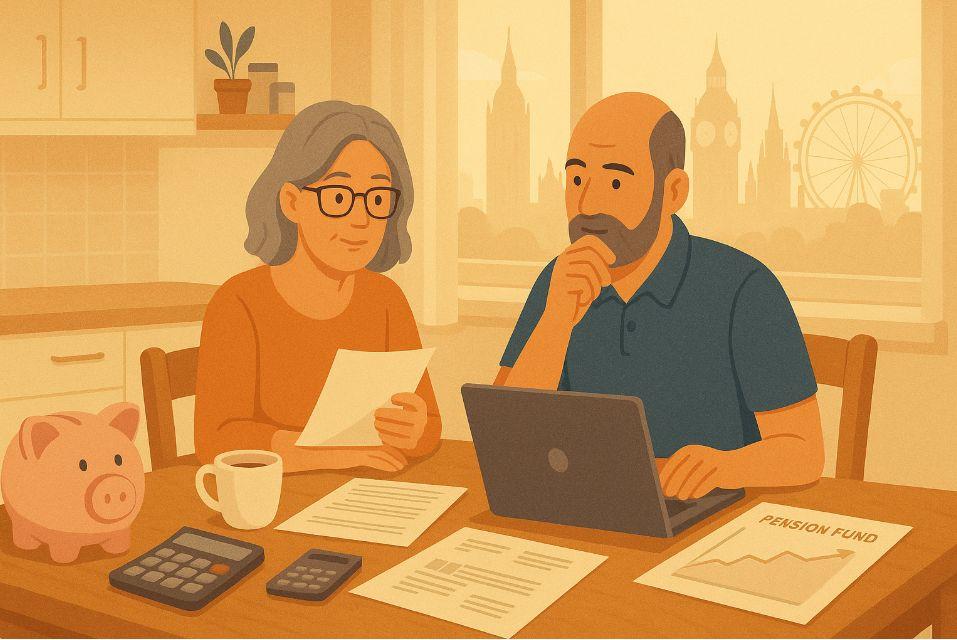The UK pension system continues to evolve, and among its most significant features is the option to take a lump sum from your pension pot. For many approaching retirement, the HMRC pension savers lump sum represents a flexible way to access pension savings offering both opportunities and potential pitfalls. But how does it really work?
Understanding how much you can withdraw, what portion is tax-free, and what the long-term implications are has never been more important. With the Lifetime Allowance abolished in 2023 and new guidance from HMRC on reversing lump sums, pension savers in the UK particularly those in London, where financial planning is increasingly sophisticated need clarity more than ever.
This article unpacks everything you need to know about taking a pension lump sum and how HMRC is managing the process.
What Is the HMRC Pension Savers Lump Sum Scheme?

The Pension Savers Lump Sum is a term widely used to describe HMRC’s tax treatment of lump sum withdrawals from pension pots. Generally, individuals in the UK with a defined contribution pension can take up to 25% of their pot tax-free once they reach the minimum pension age, which is currently 55 (rising to 57 in 2028). This tax-free element is called the Pension Commencement Lump Sum (PCLS).
Following the abolition of the Lifetime Allowance (LTA) in April 2023, there’s now no cap on the amount you can accumulate in your pension without facing an additional tax charge. However, standard income tax rules still apply to any amount withdrawn beyond the tax-free portion. The scheme is designed to give savers greater control and flexibility as they transition into retirement.
How Much Can You Take as a Tax-Free Pension Lump Sum in the UK?
The standard entitlement allows individuals to withdraw 25% of their pension savings tax-free. For example, if a pension pot is worth £160,000, the tax-free lump sum would be £40,000. The remaining £120,000 can be withdrawn in full or in stages, but it will be taxed at the individual’s marginal income tax rate.
Importantly, while there’s no longer a Lifetime Allowance restricting the size of your pension, you still need to plan carefully. Withdrawing too much too soon may push you into a higher tax band, or worse, deplete your pension before you need it most. Therefore, many choose to take their tax-free cash and leave the rest invested until a more tax-efficient opportunity arises.
When Can You Access Your Pension Lump Sum According to HMRC?
Currently, HMRC allows access to pension pots from age 55, although this will increase to 57 in 2028 to reflect longer life expectancy. There are exceptions, including cases of serious ill health or certain protected pensions that may allow earlier access.
However, just because you can access your pension doesn’t mean you should. Withdrawing too early could have consequences not just in terms of tax, but also your long-term financial security. If you’re still earning a full income, adding pension withdrawals on top could unnecessarily elevate your tax bill.
Is the Pension Savers Lump Sum Taxable After the 25% Allowance?

Yes. Once the tax-free portion is withdrawn, any additional amount is taxed as income. For example, if a saver withdraws £100,000 and £25,000 is tax-free, the remaining £75,000 is treated as income for that tax year and taxed according to the relevant tax bands.
Pension withdrawals are subject to PAYE (Pay As You Earn), so your pension provider will likely deduct tax before you receive your payment. However, this sometimes results in overtaxation, especially when an emergency tax code is used. If this happens, you can claim a refund using HMRC forms such as P55, P50Z, or P53Z, depending on your employment status and the withdrawal amount.
How Does the Lump Sum Affect Your Lifetime Allowance and Retirement Income?
While the Lifetime Allowance has been removed, which means you won’t be penalised for accumulating large pension pots, that doesn’t mean lump sum decisions are risk-free. Withdrawing a large sum reduces the capital available to generate future income and can lead to less sustainable retirement finances.
A further consideration is the Money Purchase Annual Allowance (MPAA). If you start drawing from your pension pot using flexible options like lump sums or drawdown, the amount you can contribute back into your pension with tax relief drops from £60,000 to just £10,000 per year. This can severely limit future pension growth, especially for those returning to work later in life.
There’s also a new compliance issue arising from recent HMRC enforcement activity: some savers who took large lump sums before April 6, 2023, have attempted to return those sums to their pension in order to benefit from the abolished LTA. HMRC is now actively investigating and penalising such reversals, arguing they amount to tax avoidance.
This includes issuing discovery assessments to collect unpaid tax. These developments are a stark reminder that pension planning must stay within HMRC’s current rules.
Can You Take Multiple Lump Sums from Your Pension Pot?
Yes, under current UK rules, it is entirely legal and often advantageous to take multiple smaller lump sums rather than a single large one. This can be done through Uncrystallised Funds Pension Lump Sums (UFPLS) or a flexi-access drawdown arrangement.
Each UFPLS withdrawal typically provides 25% of the amount tax-free, with the rest taxed as income. This strategy can be particularly useful for individuals looking to manage their annual tax liability, as it allows withdrawals to be spread across multiple tax years. Flexi-access drawdown also offers similar flexibility, allowing savers to take income as needed while the remaining funds stay invested.
What Are the Risks of Taking a Large Pension Lump Sum Early?

While taking a pension lump sum early may seem financially liberating, it carries a number of risks. One of the most immediate is the tax impact. A significant withdrawal could easily push a saver into a higher tax band, reducing the actual value of the lump sum received.
There are also implications for means-tested benefits, such as pension credit or housing support. Holding or spending a large lump sum can reduce or eliminate eligibility. Furthermore, early withdrawals deplete the capital available for future income, potentially jeopardising long-term financial independence.
As reported recently by The Telegraph, HMRC is now targeting individuals who withdrew lump sums and later returned them, particularly those who did so shortly before the Lifetime Allowance was abolished.
These reversed transactions are now being treated as tax avoidance, with HMRC issuing assessments to recoup tax liabilities on funds that were temporarily withdrawn to exploit legislative changes. This situation demonstrates the dangers of acting on assumptions about future policy rather than current guidance.
How Do You Report Your Lump Sum Withdrawal to HMRC?
In most cases, HMRC is notified automatically by your pension provider through the PAYE system, where tax is deducted at source. However, because of the way emergency tax codes work, many pension savers are overtaxed on their first withdrawal.
If you’ve been overtaxed or made multiple withdrawals in a tax year, you can submit a claim to HMRC directly. The form to use depends on your status:
- P55: For partial pension withdrawals when you’re not taking regular income
- P50Z: If you’ve withdrawn your entire pension and stopped working
- P53Z: If you’ve withdrawn your entire pension but still have other sources of income
Refunds are typically processed within 30 working days, but timing may vary depending on case complexity.
What Tools and Calculators Can Help You Plan Your Pension Lump Sum?
Several reliable tools exist to help you plan your pension lump sum. HMRC provides a Pension Tax Calculator, which estimates the amount of tax due on any withdrawal, allowing you to budget accordingly.
For more comprehensive planning, MoneyHelper and Pension Wise offer free online calculators and one-on-one sessions. These services guide you through withdrawal strategies, tax management, and long-term sustainability of your pension. For personalised support especially if you have multiple pension pots or substantial assets. it’s best to speak with an FCA-regulated financial advisor.
Pension Lump Sum Scenarios & Tax Outcomes
| Pension Pot | 25% Tax-Free | Taxable Portion | Estimated Tax Paid (20%) | Net Lump Sum |
| £100,000 | £25,000 | £75,000 | £15,000 | £85,000 |
| £200,000 | £50,000 | £150,000 | £30,000 | £170,000 |
| £300,000 | £75,000 | £225,000 | £60,000 | £240,000 |
Conclusion
The HMRC Pension Savers Lump Sum provides valuable flexibility for pension savers but with that flexibility comes the need for careful planning. From taxation to timing, and from reporting rules to long-term income needs, this isn’t a one-size-fits-all decision.
What’s clear is that HMRC is watching closely. Recent enforcement around reversed withdrawals highlights the importance of acting within current regulations not predicted ones. By using official tools, seeking guidance from authorised experts, and avoiding risky strategies, pension savers can make informed, confident decisions about their retirement income.
FAQs
Can I take my 25% tax-free lump sum in stages?
Yes. Through UFPLS or drawdown, you can take smaller tax-free amounts over time, reducing overall tax exposure.
Do I need to inform HMRC every time I withdraw?
Not always. Most pension providers report directly to HMRC, but if you believe you’ve been overtaxed, you’ll need to contact them directly to claim a refund.
Does taking a lump sum affect my state pension?
No. State pension entitlement is based on National Insurance contributions and is not affected by private pension withdrawals.
Can I take a lump sum and still work?
Yes. You can be employed while withdrawing lump sums, although this may increase your income tax liability.
What if I die after withdrawing part of my pension?
Remaining funds can be passed to beneficiaries. The tax treatment depends on your age at death before 75 is usually tax-free, after 75 it’s taxed as income.
Should I take my lump sum now or wait?
It depends on your financial needs, tax situation, and other income sources. A financial adviser can help you decide what’s best.
How can I avoid HMRC penalties related to returned lump sums?
Avoid trying to reverse lump sum withdrawals to exploit tax rule changes. HMRC is actively investigating such practices and may issue penalties.









Leave feedback about this